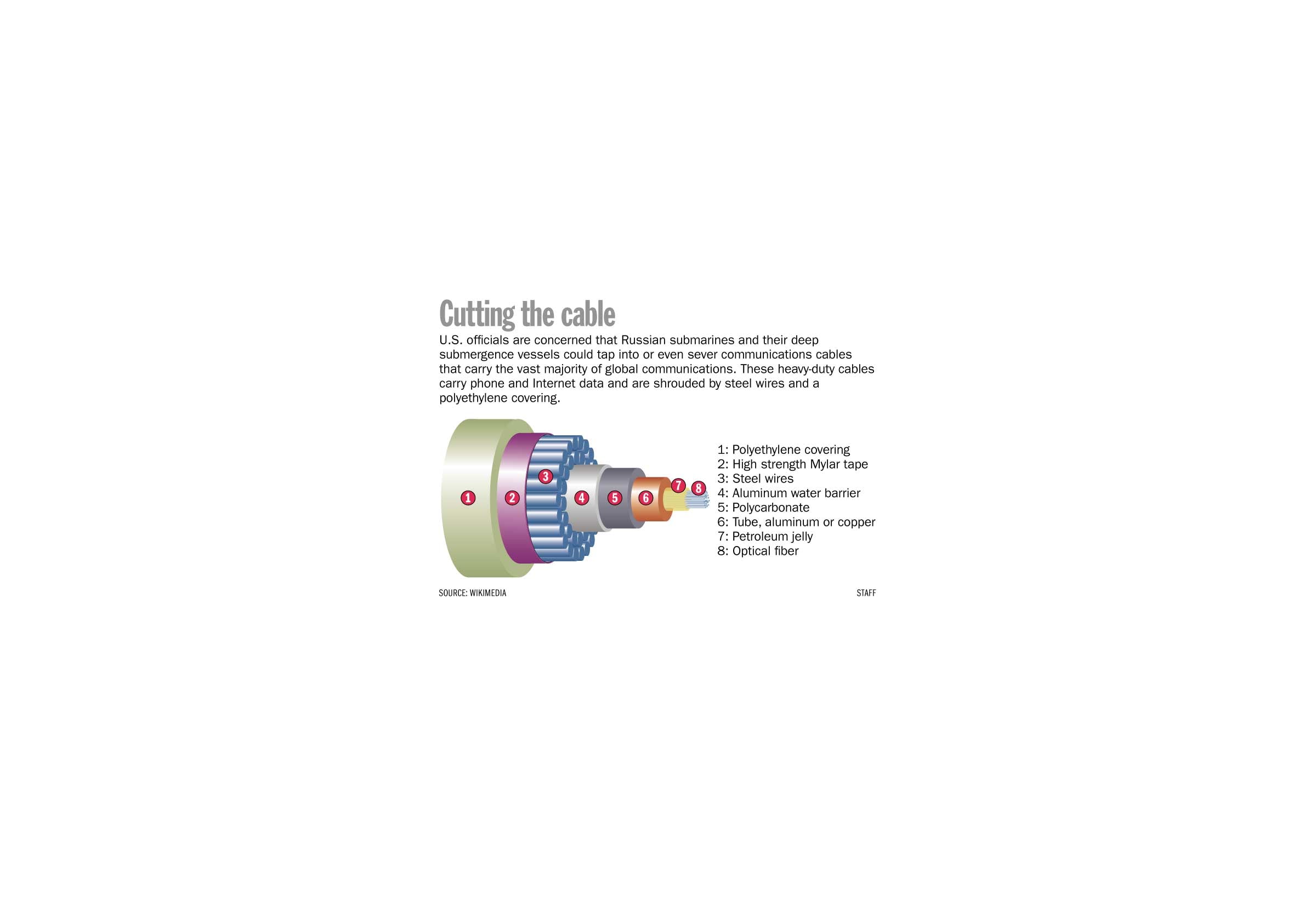U.S. leaders are increasingly worried that Russia's submarines could sever the communication arteries that drive global commerce.
The communications cables criss-cross tens of thousands of miles of ocean to relay Internet and phone data between continents. The concerns arose in September, when a Russian spy ship armed with two unmanned submersibles was detected in the vicinity of the cables, raising fears that the Russians might be planning to cut the cables in the event of a crisis, according to an Oct. 25 article in The New York Times.
Recent reports of Russia operating in the vicinity of submarine cables that carry nearly all the world's internet data has brought discussions largely held in classified settings to the fore: How might the Navy defend thousands of miles of critical infrastructure?
The Russian operation has brought discussions normally held in classified settings to the fore: How can the U.S. Navy safeguard thousands of miles of critical infrastructure? It's a vexing issue in at a time when the Navy's forces are already stretched thin in the Middle East and while confronting emerging near-peer competitors adversaries such as like Russia and China, but a major interruption in internet service could wreak havoc on the global economy, something that was less of a threat during the Cold War.
Navy leaders are starting to raise the alarm about this potential choke point, and the solution they propose is autonomous underwater systems.
The head of the nuclear Navy said in an October presentation that the Navy needed to invest heavily in unmanned underwater systems to protect undersea infrastructure.
"The necessity exists because of challenges we face from potential adversaries," said Adm. Frank Caldwell Jr., head of Naval Reactors, in an October briefing. "It exists because of the submarine [building] hiatus we took in the 1990s and the impending dip [in] force structure we'll have late in the 2020s ... and we may be called upon in the future to protect undersea infrastructure, something we haven't really considered before."
"You add all these up, I think there is an imperative to move forward more swiftly in this unmanned realm," he said.

U.S. officials are concerned that Russian submarines and their deep submergence vessels could tap into or even sever communications cables that carry the vast majority of global communications. These heavy-duty cables carry phone and Internet data and are shrouded by steel wires and a polyethylene covering.
Photo Credit: Wikimedia
To be sure, the vulnerability of undersea cables isn't a new concern in warfare. The Royal Navy severed German transoceanic cable lines in the opening days of World War I, impairing their secure communications. And the U.S. submarine Parche famously tapped Soviet military cables in 1979, among the foremost known feats of the Cold War.
"Russians taking an interest in our submarine cables — it's not a new thing," said Bryan Clark, a retired submarine officer and analyst with the Center for Strategic and Budgetary Assessments in Washington. "But people are realizing the volume of traffic that goes over submarine cables now, relative to where it was in the Cold War."
In September, a Russian spy ship armed with two unmanned submersibles was detected in the vicinity of the cables, raising fears that the Russians might be planning to cut the cables in the event of a crisis, according to an October 25 report in the New York Times.
The cables themselves are most vulnerable near the continental shelf, the place where the landmass drops suddenly to and reaches depths that make them more difficult to access or cut, Clark said. And while day-to-day protection of the cables is the responsibility of the telecom companies that lay and operate them, the Navy would need to protect them against an in the event of an imminent threat.
It would be virtually impossible to defendsafeguard thousands of miles of cables, but submarine bosses say it's possible to protect critical nodes. That's a job that can be done increasingly with unmanned systems, rather than using already busytaxed attack boats.
"We don't have to know everything everywhere," said retired Vice Adm. Michael Connor, former head of Submarine Forces at an Oct. 27 House Subcommittee hearing. "But there are places where you would like to have very good knowledge.," said retired Vice Adm. Michael Connor, former head of Submarine Forces at an Oct. 27 House Subcommittee hearing about emerging underwater systems. "We have critical things we want to protect, like some of the undersea infrastructure that is so critical to our economy."
"There may be places we decide we want to have some volume of systems and that relatively small area around that infrastructure where you would have sufficient vehicles to obtain perfect knowledge," he said.
Combating unmanned underwater vehicles is also a tough nut to crack because they are often small, quiet, made of plastic and extremely difficult to detect.
Experts say that technology under development could help address the problem of protecting important cable nodes. Upward Falling Payload modules under development by the Defense Advanced Research Projects Agency could be placed on the seabed nearby and, when an intrusion or threat is detected, could pop to the surface and inform operators of the attack, said Alan Beam, who headed DARPA's UUV division at the Defense Advanced Research Projects Agency in the 1990s.
Combating the threat to the cables is a tough nut to crack, and the Russians are a formidable adversary in the undersea realm, an area where they have invested money consistently even after the fall of the Soviet Union, said a retired submarine skipper who now works in the submarine industryfor General Dynamics Electric Boat.
The sonar nets and undersea surveillance systems that were so effective at tracking Russian subs in the Cold War, likely prompted Russia to invest in autonomous underwater vehicles and seabed systems to get around U.S. defenses because unmanned underwater systems are so hard to track.
"Protecting any system against an autonomous unmanned undersea vehicle would be extremely difficult," the retired captain said in an email. "These vehicles are propelled by quiet, battery powered electric motors — they have almost no acoustic signature. In addition, they are physically small and would not provide a large return if active sonar was used to search for them."
Given the difficulties involved in protecting cables, it will be important to invest in additional, secret infrastructure, said retired former NATO top officer Adm. James G. Stavridis, in an op-ed in The Huffington Post.
"We need to build more resiliency and redundancy into the underwater cable network," wrote Stavridis, who served as NATO's top military commander. "It is far too vulnerable to sabotage, especially at the terminals where the cables are in relatively shallow water. We need more 'dark cables' that are not operational but kept in reserve."
David B. Larter was the naval warfare reporter for Defense News.





